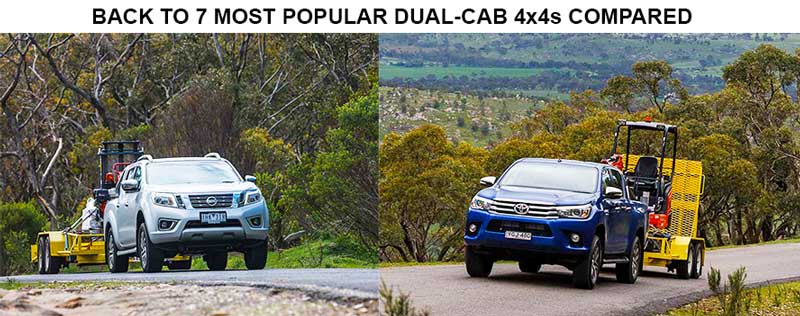Mitsubishi’s new Triton is the lightweight in this lot but does that really matter?
The Mitsubishi Triton is an-all new design as of early 2015. Most notably, it has a new-generation 2.4-litre engine – the smallest engine here bar the Navara, which is 2.3 litres but has the benefit of two sequentially arranged turbos to provide extra grunt.
The Triton is also notably smaller and lighter than the Ranger and BT-50 in particular, and it’s also smaller than the Colorado and the D-Max.
 |
|
The Triton surprised with 2.8 tonne behind it
|
The Mitsubishi Triton’s tub has four small and less useful tie-downs to secure the 800kg pallet. Once loaded, the Triton’s rear drops some 105mm – almost twice the droop of the utes least affected by the load. The trouble is the Triton has a notably short wheelbase, and most of the tub is behind the line of the rear axle.
The 800kg pallet plus the driver/observer/tow bar also stretches the Triton in terms of legal payload. The base-spec model is okay, but the top-spec Exceed falls 40kg short, so technically the observer has to get out and walk!
The Triton definitely feels nose up heading up the hill with the 800kg in the tub, although the steering feel and general chassis stability is still okay, even if the rear suspension does bottom out a few times on the bigger bumps.
It’s worth noting the Triton is the only ute here to offer full-time four-wheel drive via Mitsubishi’s ‘Super Select’ system, which also has a two-wheel drive mode. This is no big deal on dry roads, but full-time 4×4 brings significant drivability and safety advantages when hauling or towing heavy loads on wet roads.
While the Triton’s chassis certainly reacted to the weight of the pallet, the 2.4-litre engine made a much better fist of things. It needs more revs than the other engines here to do the job (maximum torque is 2500rpm), but it still did it well nonetheless.
And while it likes to rev, it’s still quiet and refined. If there’s one way to make a smooth-running and quiet diesel, it’s to drop the capacity to overcome the inherent vibration of the in-line four. Big fours vibrate more than little fours, it’s as simple as that.
What’s more, the Triton’s 2.4 also has a low compression ratio of 15.5:1 – another way to improve refinement and cut down NOx emissions, a ‘main-game’ issue right now for diesel engines.
The engine does well despite having only five ratios to play with in a gearbox that now feels old in terms of shift quality. One positive here, however, is the Triton is the only ute with paddle shifters, which are more than handy for decent control given the Triton doesn’t have much engine braking.
TOW TEST
I have to fess up and say that I wasn’t holding out high hopes for the performance of the Mitsi on this test. It’s specced for lighter towing, and the short wheelbase and long rear overhang of the Triton has it pegged as not being the most worthy of towing contenders.
Well, I have to say I was most surprised. Our lighter 2800kg trailer didn’t have as much vertical impact on the Triton’s posterior as I thought. It knew it was there, but it certainly wasn’t dragging its bum on the ground.
The biggest star of the Mitsubishi show, however, was the performance of the 133kW 2.4-litre engine. The diminutive donk punches above its weight once it gets some boost and some rpm up, and puts the 430Nm it creates into play.
Sure, it’s a revvy little unit, and it suffers from turbo lag off the line. But at peak torque between 2500-3000rpm, with the snail sucking in some atmosphere, the little Mitsi really stepped up to the mark.
While the tranny still needed a nudge to do the right thing, this was negated by the rather nifty paddle shift on the steering column. Manual intervention was a fingertip away, and Mitsubishi is to be commended for leaving the paddles fixed on the column rather than spinning with the wheel itself. It ain’t a sports car, and the fixed paddle position is much more practical on a 4×4 load hauler.
The smaller engine meant that it doesn’t have much to give in the back pressure stakes. Using engine rpm to try and hold back the Triton under load results in flight revs rather than any real braking effect.
MITSUBISHI TRITON PRICE
Mitsubishi Triton GLX: $36,490
Mitsubishi Triton GLX+: $36,990
Mitsubishi Triton GLS: $40,990
Mitsubishi Triton Exceed (auto): $47,790
*4×4 dual-cab pick-up manual only unless noted.
MITSUBISHI TRITON SPECS
Engine
2.4-litre 4-cyl turbo diesel
Max torque/power
133kW/430Nm
Gearbox
Five-speed automatic
4×4 system
Dual-range full-time (+2WD)
Kerb weight
1930kg to 1965kg
GVM
2900kg
Payload
935kg to 970kg
Towing capacity
3100kg
Towball download (max)
310kg
GCM
5885kg
Fuel tank capacity
75 litres
ADR fuel claim
7.6 litres/100km
*4×4 dual-cab pick-up automatics only.
Photography: Ellen Dewar and Nathan Jacobs




